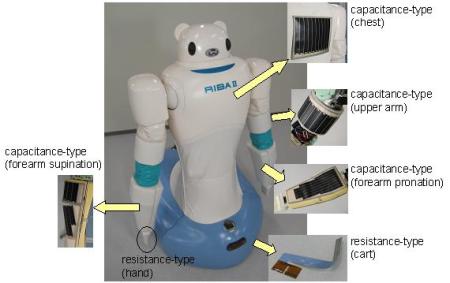The research team from RIKEN and Tokai Rubber Industries (TRI) have come together to build a new robot with high-precision sensors for the care of the elderly. The robot called RIBA II (Robot for Interactive Body Assistance) is capable of lifting patients as heavy as 80 kg off the floor and place them on a wheelchair.
 Locations of Smart Rubber sensors in RIBA-II
Locations of Smart Rubber sensors in RIBA-II
In Japan, there is an urgent need for providing care for the elderly population, which is bound to reach 5.69 million by the year 2015. Of all the tasks, in the care of the elderly, the most difficult and causing much strain is the lifting of patients from the floor level and placing them on the wheel chair. Intervention of robots in such tasks is most ideal as they are capable of lifting heavy weights, any number of times in a day.
In the year 2009, the research team from RIKEN-TRI Collaboration Center for Human-Interactive Robot Research (TRC) located in central Japan, had created the RIBA robot with the aim of helping in elderly care. This was the first robot of its kind for elderly care; however, some inherent limitations prevented the robot from becoming a commercial success. Now they have come up with the RIBA-II, in which the limitations in its predecessor are absent, the new robot is equipped with improved joints at the base and lower back to enable it to lift patients off the floor. Smart Rubber sensors of tactile capacitance-type made of rubber are printed on sheets and fitted on the robot’s arms and chest. The sensors provide highly accurate tactile guidance, using which the robot is able to gauge the weight by merely touching the patient. The RIBA-II is able to lift patients ensuring their safety. The next step for the research team is to work with nursing care facilities and fine tune RIBA-II’s features to suit the needs of care givers and their patients to assist them in rehabilitation. TRI intends to commercialise the robot shortly to cater for the care of the aging population across the world.